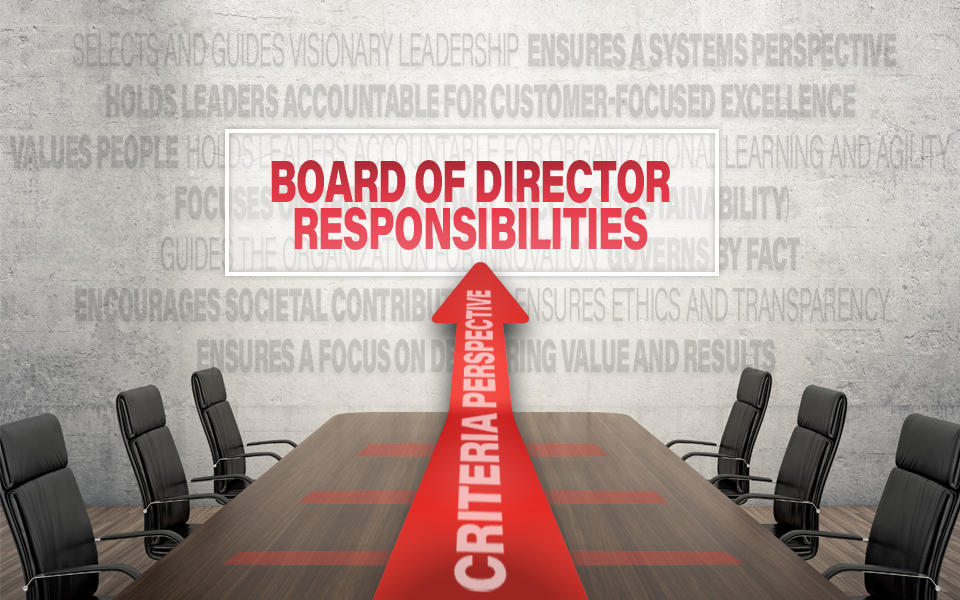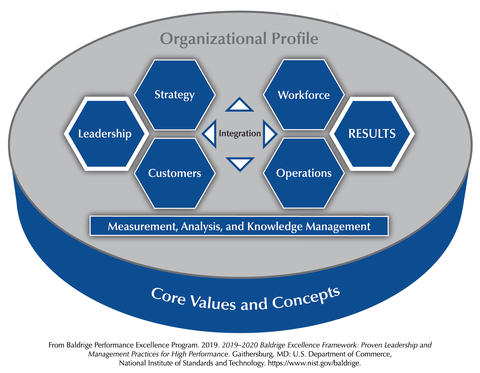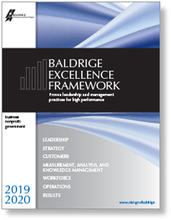Blogrige
The Official Baldrige Blog
Board of Director Responsibilities: A Baldrige Criteria Perspective

The Baldrige Excellence Framework is underpinned by a set of 11 core values and concepts. These core values have guided both the development and understanding of the Baldrige Criteria for many years. They have served as the basis for defining role model leadership attributes. These leadership attributes, with a focus on the roles that Boards of Directors play, have been highlighted in a previous Blogrige blog.
The Baldrige Excellence Framework’s Criteria for Performance Excellence define the critical factors that drive organizational success. Answering the questions in the Criteria can guide improvement and innovation in all types of organizations. Through the Criteria’s Organizational Profile, your responses to the questions can be tailored to meet the unique needs of your organization.
For the members of a Board of Directors, the Criteria can be a valuable tool for governing and guiding your organization. The seven categories of the Criteria cover all aspects of organizational performance. Can you and/or your organization’s senior leaders answer these questions? If not, your organization may have gaps that could require leadership’s attention.

Here are a few important questions from the Criteria that Directors should consider.
Category 1, Leadership
- How does your organization ensure responsible governance, including accountability for senior leaders’ actions, accountability for strategy, fiscal accountability, transparency in operations, independence and effectiveness of internal and external audits, and succession planning for senior leaders?
- How do you evaluate the performance of your senior leaders and your governance board?
- How do you address current and anticipate future legal, regulatory, and community concerns with your products and operations?
- How do you promote and ensure ethical behavior in all interactions?
Category 2, Strategy
- How does your strategic planning process stimulate and incorporate innovation?
- How does your strategic planning include these key elements of risk: your strategic challenges and advantages, potential changes in your regulatory and external environment, potential blind spots, and your ability to execute the plan?
- How do your strategic objectives achieve appropriate balance among varying and potentially competing organizational needs?
- How do you recognize and respond when circumstances require a shift in action plans and rapid execution of new plans?
Category 3, Customers
How do you market, build, and manage relationships with customers to acquire customers and build market share, manage and enhance your brand image, and retain customers and exceed their expectations in each stage of the customer life cycle?
Category 4, Measurement, Analysis, and Knowledge Management
- How do you review your organization’s performance and capabilities to assess organizational success, financial health, progress on strategic objectives, and to respond rapidly to changing organizational needs and challenges in your operating environment?
- How do you use your knowledge and resources to embed learning in the way your organization operates?
Category 5, Workforce
- How do you address your workforce capability and capacity needs?
- How do you foster an organizational culture that is characterized by open communication, high performance, and an engaged workforce?
- How do you manage career development for your workforce and your future leaders?
Category 6, Operations
- How do you manage the cost, efficiency, and effectiveness of your operations?
- How do you ensure the security and cybersecurity of sensitive or privileged data and information and of key assets?
- How do you ensure that your organization is prepared for disasters or emergencies?
Category 7, Results
- What are your results for your products and your customer service processes, and how do they compare with the results of competitors or similar organizations?
- What are your results for governance accountability, legal and regulatory requirements, ethical behavior, and support of your key communities?
- What are your results for financial and marketplace performance?
- What are your results for the achievement of your organizational strategy?
How do questions from the Criteria help Directors?
The Baldrige Criteria for Performance Excellence provide a basis for conducting organizational self-assessments and for awarding the Malcolm Baldrige National Quality Award. The Criteria also provide a framework for directors to use in overseeing and monitoring an organization’s performance. As part of their due diligence, directors are expected to be familiar with the organization and its markets; to ask appropriate questions of leaders and each other; to challenge assumptions; and to seek expert advice when needed. The Baldrige Criteria support you by providing performance-related questions that can be used in soliciting information from leadership and outside experts and in questioning assumptions.
How can Directors start using the Baldrige Excellence Framework?
The questions listed above are a great starting point. There are several additional opportunities.
Use the Organizational Profile.
The Organizational Profile is the preface to the Criteria. Answers to the questions in this brief section provide a snapshot of the organization, including its governance system, regulatory environment, strategic challenges, and system for performance improvement. Many organizations start their self-assessments with the Organizational Profile. It also is useful for orientation and training of directors, as well as regular inclusion in board books.
Use the full Criteria for Performance Excellence.
For a more comprehensive assessment of the organization, directors—and the organization—can use the full Criteria for Performance Excellence. You can select the Criteria document that best applies to your organization: Business/Nonprofit, Education, or Health Care. While the basic requirements are consistent among these documents, each one contains adaptations specific to the sector.
Use Board of Directors: A Baldrige Core Values Perspective.
The Baldrige Excellence Framework is underpinned by a set of 11 core values and concepts. This core values perspective includes specific examples from the roles that Boards of Directors play.

Baldrige Excellence Framework
The Baldrige Excellence Framework has empowered organizations to accomplish their missions, improve results, and become more competitive. It includes the Criteria for Performance Excellence, core values and concepts, and guidelines for evaluating your processes and results.
Purchase your copy today!
Available versions: Business/Nonprofit, Education, and Health Care
About the author
Related Posts
Comments
thanks for your tthe explanation role of directors.....the question....how the director knows the level of integration system in organization.??
The concept of integration involves the parts of the system working together to function as a living organism, e.g. the brains, arms, legs, and heart all working to achieve excellence together. The Board oversees the direction of the organization to ensure this happens in partnership with the senior leaders.
Great piece of work!
Overdue
thanks for your guide....how directors to know integrted management system in organization
The Board of Directors Responsibility dashboard is well articulated, relevant and a sustainable enabler.






I like very much the content is tight. Thank you.มชอบมากมาก คอนเท้นส์เนื้อหาสาระแน่น ขอบคุณครับ 🌌🙏🙏🙏